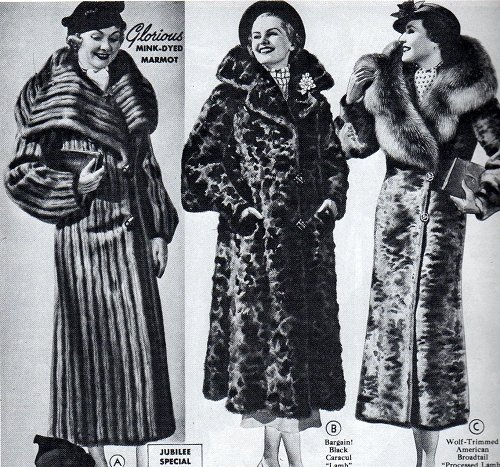
Fur coats from Sears catalog, 1937. It took a lot of skins sewn together to make these coats from marmots (a large squirrel), or “caracul,” (unborn lamb) or “broadtail.” (From Karakul, a breed of sheep.)
Was Ice Age fur clothing that fit closely a factor in the triumph of our ancestors over Neanderthals? [Elsewhere, gene research shows that there was interbreeding between the two groups….]
An article in New Scientist, 13 August 2016, page 10, summarizes an ongoing debate among anthropologists about the clothing worn by Neanderthals versus clothing worn by early humans colonizing Europe:
“An analysis of animal remains at prehistoric hominin sites across Europe suggests modern humans clad themselves in snug, fur-trimmed clothing, while Neanderthals probably opted for simple capes….”
“The idea is that Neanderthals made capes of fur, or even simply wore the skin of a large animal around their shoulders. Modern humans, meanwhile, might have opted for a more practical look; what [Mark Collard at Simon Fraser University in Burnaby, Canada] calls ‘close-fitting sewn garments.’ “

A fur coat from Paris, sketched in Delineator, 1928, and a muskrat skin fur coat from Sears, 1930.
Scientists examining animal remains from human sites have noticed that weasel, wolverine, and dog remains are found at sites occupied by humans — but not at Neanderthal sites. “Humans may have created complex garments, each stitched together from several animal skins, and so caught more animals. Neanderthals might have caught fewer because they wore much simpler clothes.”
Early human sites show plenty of “weasel, wolverine, and dog remains….” Well, a mink is a species of weasel, but would 20th century women have been eager to buy a “weasel coat?” “Mink” just sounds better.

Ads for Imperial Fur Coats, 1937. These are made from “Dyed Coney:” rabbit skins.
The jury is still out on what Neanderthals wore in Ice Age Europe, but “24,000 year-old carved figurines from Siberia suggest hoodies [hooded capes] were in vogue.”

A cozy coat made of lapin — another word for rabbit. 1937.
I’ve often recommended the book Women’s Work, The First 20,000 Years, for its examination of the importance of textiles in ancient economies.
This brief article in New Scientist has me hoping the sewing needle will take its place alongside the ax, the spear, and the arrowhead as an important technical advance by early humans.
Note: Since I don’t have any photos of early humans or Neanderthals, I chose to show 20th century coats made by sewing together many small animals’ skins; the remains of many smallish animals at early human sites suggest that they did the same.
It takes a lot of raccoons (and a lot of sewing) to make a coonskin coat, as seen this image used by Alison Lurie in The Language of Clothes:

Raccoon coats in New York City, Photo by James Van Der Zee. 1932. There was a mania for raccoon coats, especially among college students, in the 1920s.

The raccoon coat tells the story: In this 1934 cartoon, a college boy returns to the family business — and the realities of the Depression. (There’s a National Recovery Act poster on the window.) Esquire, Mar. 1934, p. 90.
Of course, now that the Ice Age has ended, I’m more partial to fur that’s being worn by the original owner:

